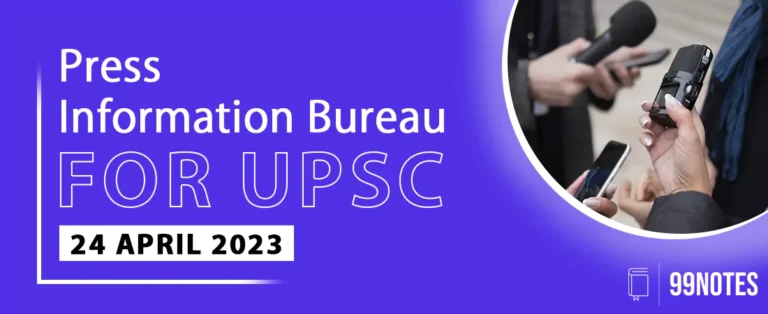15 September 2023 : PIB
PRESS INFORMATION BUREAU
15-September -2023
Daily Current Affairs For UPSC ,The PIB ( Press Information Bureau )
1. Prime Minister lauds Supreme Court of India coming under the National Judicial Data Grid platform
Topic: GS2 – Digital governance
Context:
- Prime Minister Narendra Modi praised Chief Justice of India (CJI) DY Chandrachud for announcing the integration of the Supreme Court of India into the National Judicial Data Grid platform.
- This integration allows for the tracking of pending cases, contributing to greater transparency and improving the justice delivery system in India.
About National Judicial Data Grid platform:
- The National Judicial Data Grid (NJDG) is an online database of orders, judgments, and case details of 18,735 District and Subordinate Courts and High Courts in India. It was created as an online platform under the eCourts Project in 2020.
- The NJDG is a powerful tool for monitoring pendency and disposal of cases in the Indian judicial system.
- It provides near real-time data on the status of cases, which can be used to identify and address bottlenecks and delays. The NJDG also helps to improve transparency and accountability in the judicial system, by making case data available to the public.
Here are some of the benefits of the NJDG:
- For the judiciary: The NJDG helps the judiciary to identify and address bottlenecks and delays in the system. It also helps to improve the performance of courts by providing them with data on their performance.
- For the public: The NJDG provides the public with easy access to information about the status of their cases. This helps to improve transparency and accountability in the judicial system. It also makes it easier for the public to track the progress of their cases and to understand the judicial system.
- For the media:The NJDG provides the media with access to data on the status of cases and on the performance of courts. This helps the media to report on the judicial system in a more accurate and informed way.
Source: https://pib.gov.in/PressReleseDetail.aspx?PRID=1957299
2. India marks one year of launch of National Logistics Policy.
Topic: GS3 – infrastructure sector
Context:
- The National Logistics Policy (NLP) was launched by Prime Minister Narendra Modi on September 17, 2022.
- The NLP is designed to complement the PM GatiShakti National Master Plan (NMP).
- PM GatiShakti NMP focuses on integrated development of fixed infrastructure and network planning.
About National Logistics Policy:
- The National Logistics Policy (NLP) is a comprehensive policy framework for the development of the logistics sector in India. It was launched by the Prime Minister of India on September 17, 2022.
- The NLP aims to reduce the cost of logistics in India from the current 13-14% to 5-7% of GDP, which is at par with developed countries. This will make Indian products more competitive in the global market and boost economic growth.
- The NLP focuses on a number of key areas, including:
- Process re-engineering: The NLP aims to simplify and streamline logistics processes by reducing documentation, eliminating redundant checks, and digitizing key processes.
- Digitization: The NLP aims to promote the use of digital technologies in the logistics sector. This includes developing a single-window e-logistics platform, implementing electronic bills of lading, and tracking goods in real time.
- Multi-modal transport:The NLP aims to promote the use of multi-modal transport (e.g., road, rail, and waterways) to improve the efficiency and cost-effectiveness of logistics operations.
- Infrastructure development:The NLP aims to invest in the development of logistics infrastructure, such as warehouses, transportation networks, and logistics parks.
The NLP is expected to have a number of benefits for the Indian economy, including:
- Reduced costs:The NLP is expected to reduce the cost of logistics by up to 10%. This will make Indian products more competitive in the global market and boost economic growth.
- Increased efficiency:The NLP is expected to improve the efficiency of the logistics sector by streamlining processes and reducing documentation. This will lead to faster delivery of goods and services.
- Job creation: The NLP is expected to create millions of jobs in the logistics sector. This will help to reduce unemployment and boost the economy.
- Improved trade competitiveness:The NLP is expected to make Indian products more competitive in the global market by reducing the cost of logistics. This will boost exports and lead to economic growth.
Source: https://pib.gov.in/PressReleseDetail.aspx?PRID=1957407
3. India has emerged as one of the leading players in medical textiles
Topic: GS3 – Health sector
Context:
- The Ministry of Textiles, in collaboration with The South India Textile Research Association (SITRA), organized ‘Meditex 2023: International Conference on Scope and Opportunities in Medical Textiles.’
- The conference was held on September 13th, 2023, in Mumbai.
- The conference featured various technical sessions, including discussions on Recent Advantages and Prospects of Medical Textiles, Import Substitute: Scope and Demand of Indigenous Medical Textile Products, Entrepreneurial Pathways in medical textiles – from concept to market, Future Direction of Medical Textiles, and Standards, Certification, and Regulatory Requirements.
What are medical textiles?
- Medical textiles are textile materials and products used in medical and healthcare applications. They can be made from natural fibers, synthetic fibers, or a combination of both. Medical textiles are designed to be biocompatible, meaning that they are safe to use in contact with the human body.
- Medical textiles are used in a wide range of applications, including:
- Implantable medical devices:Medical textiles are used to make a variety of implantable medical devices, such as artificial heart valves, vascular grafts, and surgical sutures.
- Wound care:Medical textiles are used to make a variety of wound care products, such as bandages, dressings, and casts.
- Personal hygiene:Medical textiles are used to make a variety of personal hygiene products, such as diapers, sanitary napkins, and tampons.
- Infection control:Medical textiles are used to make a variety of infection control products, such as surgical masks, gowns, and drapes.
- Medical devices: Medical textiles are used to make a variety of medical devices, such as bandages, surgical sutures, and casts.
Here are some of the key benefits of medical textiles:
- Biocompatibility:Medical textiles are designed to be safe to use in contact with the human body.
- Performance:Medical textiles are designed to meet the specific performance requirements of their intended application. For example, wound care dressings need to be absorbent and breathable, while surgical masks need to be effective at filtering bacteria and viruses.
- Cost-effectiveness:Medical textiles are often more cost-effective than traditional materials used in medical applications. For example, synthetic fibers are often more durable and less expensive than natural fibers.
Source: https://pib.gov.in/PressReleseDetail.aspx?PRID=1957224
For Enquiry

15 September 2023 : PIB

15 September 2023 : The Hindu Editorial Notes PDF

15 September 2023 : Daily Current Affairs

Transport, Communication and International Trade Mains Test

Tertiary and Quaternary Activities Mains Test

Primary and Secondary Activities Mains Test

Human Development Mains Test

Population and Human Settlements Mains Test

14 September 2023 : The Hindu Editorial Notes PDF

Soil and Natural Hazards Mains Test
PIB 15 September 2023 : PIB PRESS INFORMATION BUREAU
13-September -2023
Daily Current Affairs For UPSC ,The PIB ( Press Information…
September- The Hindu Editorial 15 September 2023 : The Hindu Editorial Notes PDF The Hindu Editorial
15-September-2023
Daily Current Affairs For UPSC ,The Hindu Editorial Summary
Facebook-f
Twitter
Youtube
1. Disentangling…
Daily Current Affairs 15 September 2023 : Daily Current Affairs Daily Current Affairs
15-September-2023
Daily Current Affairs For UPSC ,Daily Current affairs of The…
Daily Mains test Series Transport, Communication and International Trade Mains Test Mains Test Series
Transport, Communication and International Trade
Q. Discuss the feature and potential…
Daily Mains test Series Tertiary and Quaternary Activities Mains Test Mains Test Series
Tertiary and Quaternary Activities
Q. Discuss the potential of tertiary sector industries…
Daily Mains test Series Primary and Secondary Activities Mains Test Mains Test Series
Primary and Secondary Activities
Q. The food processing industry in India has emerged…
Daily Mains test Series Human Development Mains Test Mains Test Series
Human Development
Q. Critically examine India’s poor performance in human development…
Daily Mains test Series Population and Human Settlements Mains Test Mains Test Series
Population and Human Settlements
Q. Write a Short note on Jarawas, Todas and Santhals….
September- The Hindu Editorial 14 September 2023 : The Hindu Editorial Notes PDF The Hindu Editorial
14-September-2023
Daily Current Affairs For UPSC ,The Hindu Editorial Summary
Facebook-f
Twitter
Youtube
The…
Daily Mains test Series Soil and Natural Hazards Mains Test Mains Test Series
Soil and Natural Hazards
Q. Both causes and consequences of the urban and rural floods…





